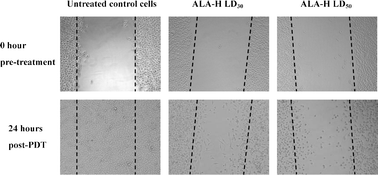Tumor invasion and immortality are the most unfavorable drawbacks after cancer treatment. In this study, we focus on determining the photodynamic modulation of the proteolytic enzymes, matrix metalloproteinases (MMP); and a core catalytic subunit of telomerase, the human telomerase reverse transcriptase (hTERT) in medulloblastoma (MED) cell line (TE-671). Hexvix (ALA-H) mediated photodynamic therapy (PDT) demonstrated greater efficacy than 5-aminolevulinic acid (5-ALA) in terms of drug uptake and anti-proliferative effect. Both MMP-2 and hTERT expression are down-regulated quantitatively using ELISA and reverse-transcriptase-PCR (RT-PCR) respectively at post-treatment for this cell line. The MMP-9 expression remains unchanged after treatment. Further, there is a statistically significant inhibition of cell migration at 24 h post-ALA-H-PDT at LD50 (0.01 mM, 2 J cm–2; p < 0.001) in MED TE-671 cells. Evidently, MMP-2 and hTERT mRNA expressions can be the targets for the photodynamic intervention on tumor cell migration and immortality. Hence, PDT may be an alternate cancer regime for medulloblastoma.

You have access to this article
 Please wait while we load your content...
Something went wrong. Try again?
Please wait while we load your content...
Something went wrong. Try again?


 Please wait while we load your content...
Please wait while we load your content...